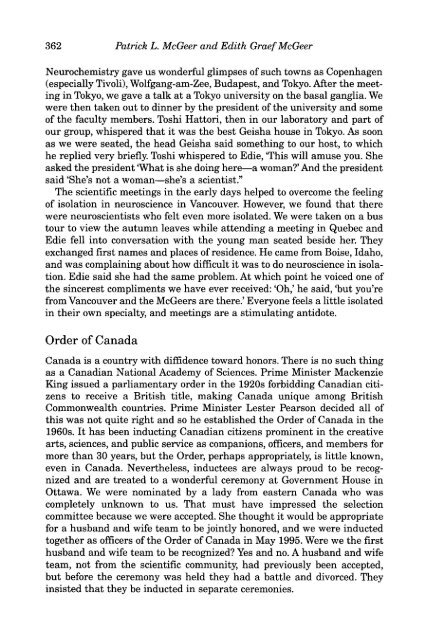Edith Graef McGeer - Society for Neuroscience
Edith Graef McGeer - Society for Neuroscience
Edith Graef McGeer - Society for Neuroscience
You also want an ePaper? Increase the reach of your titles
YUMPU automatically turns print PDFs into web optimized ePapers that Google loves.
362 Patrick L. <strong>McGeer</strong> and <strong>Edith</strong> <strong>Graef</strong><strong>McGeer</strong><br />
Neurochemistry gave us wonderful glimpses of such towns as Copenhagen<br />
(especially Tivoli), Wolfgang-am-Zee, Budapest, and Tokyo. After the meeting<br />
in Tokyo, we gave a talk at a Tokyo university on the basal ganglia. We<br />
were then taken out to dinner by the president of the university and some<br />
of the faculty members. Toshi Hattori, then in our laboratory and part of<br />
our group, whispered that it was the best Geisha house in Tokyo. As soon<br />
as we were seated, the head Geisha said something to our host, to which<br />
he replied very briefly. Toshi whispered to Edie, 'This will amuse you. She<br />
asked the president 'What is she doing here—a woman?' And the president<br />
said 'She's not a woman—she's a scientist."<br />
The scientific meetings in the early days helped to overcome the feeling<br />
of isolation in neuroscience in Vancouver. However, we found that there<br />
were neuroscientists who felt even more isolated. We were taken on a bus<br />
tour to view the autumn leaves while attending a meeting in Quebec and<br />
Edie fell into conversation with the young man seated beside her. They<br />
exchanged first names and places of residence. He came from Boise, Idaho,<br />
and was complaining about how difficult it was to do neuroscience in isolation.<br />
Edie said she had the same problem. At which point he voiced one of<br />
the sincerest compliments we have ever received: 'Oh,' he said, 'but you're<br />
from Vancouver and the <strong>McGeer</strong>s are there.' Everyone feels a little isolated<br />
in their own specialty, and meetings are a stimulating antidote.<br />
Order of Canada<br />
Canada is a country with diffidence toward honors. There is no such thing<br />
as a Canadian National Academy of Sciences. Prime Minister Mackenzie<br />
King issued a parliamentary order in the 1920s <strong>for</strong>bidding Canadian citizens<br />
to receive a British title, making Canada unique among British<br />
Commonwealth countries. Prime Minister Lester Pearson decided all of<br />
this was not quite right and so he established the Order of Canada in the<br />
1960s. It has been inducting Canadian citizens prominent in the creative<br />
arts, sciences, and public service as companions, officers, and members <strong>for</strong><br />
more than 30 years, but the Order, perhaps appropriately, is little known,<br />
even in Canada. Nevertheless, inductees are always proud to be recognized<br />
and are treated to a wonderful ceremony at Government House in<br />
Ottawa. We were nominated by a lady from eastern Canada who was<br />
completely unknown to us. That must have impressed the selection<br />
committee because we were accepted. She thought it would be appropriate<br />
<strong>for</strong> a husband and wife team to be jointly honored, and we were inducted<br />
together as officers of the Order of Canada in May 1995. Were we the first<br />
husband and wife team to be recognized? Yes and no. A husband and wife<br />
team, not from the scientific community, had previously been accepted,<br />
but be<strong>for</strong>e the ceremony was held they had a battle and divorced. They<br />
insisted that they be inducted in separate ceremonies.











![[Authors]. [Abstract Title]. - Society for Neuroscience](https://img.yumpu.com/8550710/1/190x245/authors-abstract-title-society-for-neuroscience.jpg?quality=85)





